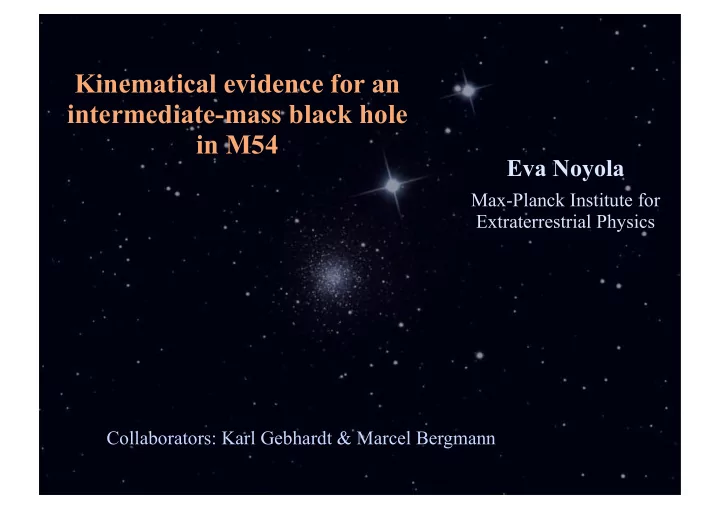

Kinematical evidence for an intermediate-mass black hole in M54 Eva Noyola Max-Planck Institute for Extraterrestrial Physics Collaborators: Karl Gebhardt & Marcel Bergmann
History and motivation for finding IMBHs in GCs • X-ray sources (Silk & Arons, 1975) • Analytical models from Bahcall & Wolf (1976) • Small sphere of influence, only resolved until recently • Seeds necessary to form SMBHs • Possible extension of M BH -sigma relation • Possible sources for gravitational wave detectors
Basic facts of star cluster dynamics Two-body relaxation Heating mechanism - Binaries - Stellar mass black holes - Stellar mass loss Core Collapse - White Dwarf kicks - Intermediate mass black hole
SB slopes distributions ~20% of HST-based SB profiles have central slopes matching N-body models with central BHs 12 10 8 6 4 2 0 0 -0.5 -1 0 -0.5 -1 SB slope SB slope Baumgardt et al (2005) 20 15 N-body simulations of star 10 clusters containing central 5 black holes predict a central shallow cusp of slope ~-0.2 in 0 0 -0.5 -1 -1.5 -2 0 -0.5 -1 -1.5 -2 surface density. LD slope LD slope Noyola & Gebhardt, 2006, 2007
Kinematic evidences for black holes in GCs M15 G1 NGC 6752 • 20,000 M ⦿ central black • Unusual millisecond • Evidence for central hole from orbit-based pulsar population black hole is inconclusive models • Measured central M/L • 3400 M ⦿ inside 0.05 pc • Alternative model fits implies 1000-2000 M ⦿ • Possible central rotation kinematics. Requires two • SB fits models for post inside 0.08 pc merging clusters • Configuration could core-collapse bounce • Central rotation detected come from single or • Flat central core in SB van den Bosch et al., 2006; double black hole of McNamara et al., 2003; • Central X-ray and radio Gerssen et al., 2002 200-500 M ⦿ emission detected Gebhardt et al., 2005; Colpi et al., 2003; D’Amico et al., 2002 Baumgardt et al., 2003 Pooley & Rappaport, 2006; Ulvestad et al., 2007
Omega Centauri ACS convolved ACS • Kinematics from Gemini- GMOS IFU • Use Calcium triplet region • Velocity dispersion measured from integrated spectra in two 5” × 5” fields • Velocity dispersion rise detected between the fields at 14” (18.6 km/s) and the central field (23.0 km/s) GMOS acquisition GMOS Noyola, Gebhardt & Bergmann 2008
Dynamical models • Central kinematics from GMOS, outer points from individual radial velocities • Spherical dynamical models assuming a constant M/L ratio and various black hole masses • Spherical models consistent with a black hole of 4±1 × 10 4 M ⦿
M54 and the Sag dwarf Ibata et al, 1997 Monaco et al, 2005 M54 could be the nucleus of the Sag dwarf galaxy
GMOS data for M54 GMOS H-alpha filter; ~700 velocities Noyola, Gebhardt & Bergmann., 2009, in prep
GNIRS data for M54 C o n v V - b a n d WFPC2 V-band WFPC2 WFPC2 V-band convolved Acq H-band IFU K-band Gemini GNIRS aqc reconst.
Velocity map • Use CO bandhead to measure kinematics • Detect rotation pattern with 13 km/s amplitude, σ = 15 km/s
Models • Best fit model has BH mass of 10 4 M ⦿ • Density and velocity inputs completed • No BH model requires some radial with other data anisotropy Bellazzini et al., 2008; Monaco et al., 2005
Conclusions • M54 shows a shallow central density cusp • GMOS data provides ~500 individual radial velocities outside the core • GNIRS data shows clear rotation at the center • Best fit model for M54 requires a 10 4 M ⦿ central BH • Stability tests are crucial to evaluate alternative scenarios
Recommend
More recommend